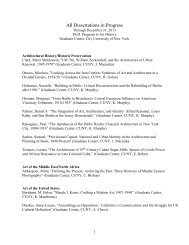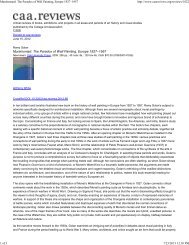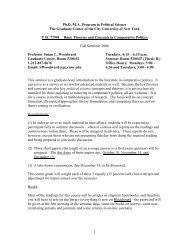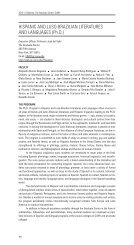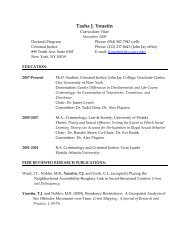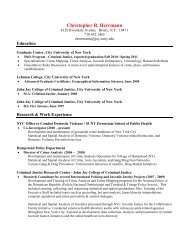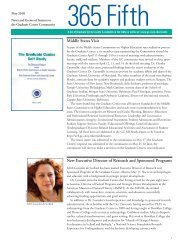Clitic climbing in Spanish imperatives - CUNY Graduate Center
Clitic climbing in Spanish imperatives - CUNY Graduate Center
Clitic climbing in Spanish imperatives - CUNY Graduate Center
You also want an ePaper? Increase the reach of your titles
YUMPU automatically turns print PDFs into web optimized ePapers that Google loves.
Marcel den Dikken & Mariví Blasco & <strong>Clitic</strong> <strong>climb<strong>in</strong>g</strong> <strong>in</strong> <strong>Spanish</strong> <strong>imperatives</strong><br />
Thus, we have identified two different ways <strong>in</strong> which ‘restructur<strong>in</strong>g’ can come about & head-to-head<br />
movement and VP%rais<strong>in</strong>g. Some of the ‘restructur<strong>in</strong>g’ pie has been reanalysed <strong>in</strong> terms of XP%movement<br />
rather than head movement; but the head movement and XP%movement derivations both exist. They are not<br />
<strong>in</strong> free variation, the two be<strong>in</strong>g used <strong>in</strong> complementary contexts. Some constructions which have traditionally<br />
been thought to <strong>in</strong>volve head movement turn out to <strong>in</strong>volve XP%movement <strong>in</strong>stead; but it seems that not all<br />
restructur<strong>in</strong>g can be reanalysed <strong>in</strong> terms of XP%movement & at least, not of the type we have proposed here.<br />
With specific reference to the analysis of <strong>imperatives</strong>, we have found that Beukema and Coopmans’<br />
(1989) conclusion that simple <strong>imperatives</strong> are not marked for Tense is correct & at least for English and<br />
<strong>Spanish</strong> (though see note 9 for an <strong>in</strong>dication that this is not a universal). We have shown that ‘be<strong>in</strong>g<br />
unmarked for Tense’ is tantamount, <strong>in</strong> the context of restructur<strong>in</strong>g <strong>in</strong> ‘come/go’ constructions, to the absence<br />
of ‘clause union’ effects <strong>in</strong> the doma<strong>in</strong> of clitic <strong>climb<strong>in</strong>g</strong> & someth<strong>in</strong>g which we have suggested may<br />
ultimately be blamed on the <strong>in</strong>ability on the part of a T%node unmarked for Tense to attract the VP <strong>in</strong> the<br />
complement of aspectual ‘come/go’ up <strong>in</strong>to its specifier position.<br />
It goes without say<strong>in</strong>g that this first stab at the analysis of the <strong>Spanish</strong> and Hungarian data laid out<br />
<strong>in</strong> this paper raises a host of questions. We express the hope that future research will be able to benefit from<br />
the discussion <strong>in</strong> these pages, and will f<strong>in</strong>d <strong>in</strong>terest<strong>in</strong>g answers to the questions raised.<br />
Notes<br />
* We would like to express our gratitude to the native speakers of Pen<strong>in</strong>sular and South-American<br />
<strong>Spanish</strong> who we tested the <strong>Spanish</strong> examples presented <strong>in</strong> this paper out on. We also thank Ricardo Otheguy,<br />
the audiences at the <strong>CUNY</strong> Syntax Supper (New York, February 2001), WCCFL XX (University of Southern<br />
California, February 2001) and ‘Imperatives and functional projections: A workshop for Frits Beukema’<br />
(Leiden, June 2001), and the editor of this volume for useful comments and discussion. We are immensely<br />
<strong>in</strong>debted to Anikó Lipták and Ildikó Tóth for <strong>in</strong>itially po<strong>in</strong>t<strong>in</strong>g out the Hungarian facts, and for their help<br />
with these data. This paper is presented to Frits Beukema, the first author’s first syntax teacher, with many<br />
thanks for his teach<strong>in</strong>g, guidance, advice, help, multiple co-authorship and friendship over the more than<br />
fifteen years that our paths have run along parallel l<strong>in</strong>es.<br />
1 For the sake of completeness, let us illustrate this <strong>in</strong> (i):<br />
(i) Lo puedo ir/venir a ver.<br />
CL I-can go/come to see<br />
2 This is true both for speakers of Pen<strong>in</strong>sular <strong>Spanish</strong> and for speakers of Lat<strong>in</strong>-American <strong>Spanish</strong>,<br />
though the strength of the contrast <strong>in</strong> (6) varies somewhat from speaker to speaker (<strong>in</strong> ways that do not, <strong>in</strong><br />
any obvious way, lend themselves to generalisations along geographical l<strong>in</strong>es). A couple of hunches are<br />
worth discard<strong>in</strong>g <strong>in</strong> this context. Johan Rooryck (p.c.) has suggested that (6b) does not meet with universal<br />
rejection because constructions with venir are ambiguous between a construal of venir as a real directional<br />
verb (literally ‘to come’) and one <strong>in</strong> which it is an aspectual auxiliary; however, we do not see how this<br />
would differentiate between (5b) and (6b). Also, one might suspect a l<strong>in</strong>k between the ban on clitic <strong>climb<strong>in</strong>g</strong><br />
and the fact that, while the <strong>Spanish</strong> s<strong>in</strong>gular imperative normally corresponds to the third s<strong>in</strong>gular presenttense<br />
<strong>in</strong>dicative form, the forms of ‘come’ (Viene vs Ven!) and ‘go’ (Va vs Ve!) do not; this suspicion is<br />
discredited, however, by the fact that haz (the imperative of hacer ‘do, make’), which likewise is special<br />
<strong>in</strong> not correspond<strong>in</strong>g to the third s<strong>in</strong>gular present-tense <strong>in</strong>dicative (hace), does not bar cliticisation: alongside<br />
non-<strong>climb<strong>in</strong>g</strong> cases like Haz leerlo en público! ‘make read-CL <strong>in</strong> public’, clitic-<strong>climb<strong>in</strong>g</strong> examples like Hazlo<br />
10



